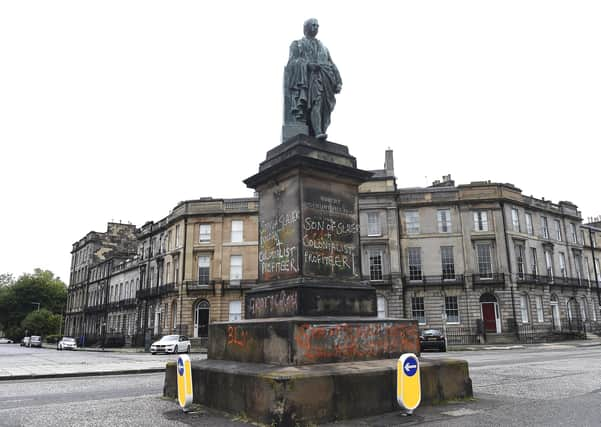Edinburgh needs to make ‘significant changes’ to rid city of slave trade links


Thousands of residents attended the Black Lives Matter demonstration in Holyrood Park on Sunday, highlighting the strength of feeling over the city’s need to cleanse itself of past wealth generated through slavery.
Links to the vile trade in human flesh can be seen across the city with statues, schools and streets named after those who profited through misery and servitude in sugar, cotton and tobacco plantations centuries ago.
Advertisement
Hide AdAdvertisement
Hide AdOthers earned their fortunes by shipping slaves from Africa to be sold in street markets and one past resident even boasted of having the first black servant in the city.
Some landmarks have been daubed with graffiti expressing anger over their links to slavery, leading to a re-think over their future.
The wording for a plaque to be added to the Melville Monument in St Andrew Square, which features slave profiteer Henry Dundas, the 1st Earl Melville, has been agreed but Edinburgh City Council leader, Adam McVey told BBC Scotland he would “have no sense of loss” if the statue were removed.
And last night, SNP Cllr Kate Campbell told the Evening News: “We have statue of a man who used his position to obstruct the ending of the slave trade in one of our most important civic spaces. That is an insult.
Advertisement
Hide AdAdvertisement
Hide Ad“We need a big conversation about the monuments and tributes to those involved in the slave trade and that conversation has to involve all of the voices from our communities.”
Cllr Campbell added: “We need to acknowledge our city’s history and be honest about the past, but we also need to be proactive about shaping our future. I think significant changes to street names, and the removal of statues, has to be part of that conversation.”
Dundas – whose 150ft monument has been daubed with anti-racism slogans – worked to frustrate efforts to end the trade by using his influence as home secretary, setting the move back 15 years.
He put forward an amendment to a bill which would abolish slavery in 1792, opting for a more gradualist approach.
Advertisement
Hide AdAdvertisement
Hide AdThis allowed the practice to continue for 15 years longer than it otherwise would have done – allowing 630,000 people to be transported to Britain as slaves.
However, Cllr McVey stressed that the statue is just “one instance” of change, adding: “This discussion will rightly continue and it’s important to listen to black and ethnic minority voices in our city in that discussion. Edinburgh’s street names and buildings are littered with the history of the good and the bad of how that wealth was created in our city.”
And responding to incidents of graffiti, Conservative Cllr Nick Cook said: “We cannot escape Edinburgh’s history and current and future generations must be fully educated on this. We won’t send a powerful message through vandalising these statues through graffiti or tearing them down, but rather by learning more about these individuals.
“Changing statues, street names and other aspects of Edinburgh’s past is not something that will occur over night and should be part of an extensive discussion within the council across all parties. We must all send a powerful message against racial hatred and Conservative councillors will look at all avenues as to how that can be achieved.”
Advertisement
Hide AdAdvertisement
Hide AdOther Edinburgh citizens with links to slavery include James Lindsay, 7th Earl of Balcarres, a New Town resident who received a large compensation payment from the British government.
The British government paid 3,000 slaveholders £20m in compensation for the emancipation of slaves in 1833, the equivalent of around £17bn today.
One of the biggest compensation payments went to Peter McClagan of Great King Street, who received £21,480 for the “407 enslaved” at a plantation in British Guyana, about £1.7m in today’s money.
John Blackburn, a slave owner and Queen Street resident, submitted three claims for 638 slaves in Jamaica.
Advertisement
Hide AdAdvertisement
Hide AdWilliam Alexander, Lord Provost of Edinburgh in 1753, owned four ships which often returned from colonies with rum, muscovado sugar, rice and mahogany.
Tobacco from the Americas arrived from slave plantations into Leith in the 17th Century, earning fortunes for some residents.
James Gillespie owned a shop at 231 High Street and made his fortune selling Virginia tobacco and snuff. Money from his fortune was left to build a school in Marchmont that still bears his name.
The Countess of Stair was reported to have the first black servant in her home in the city, which is now the Writers’ Museum.